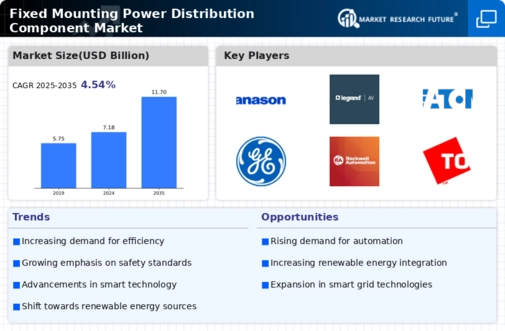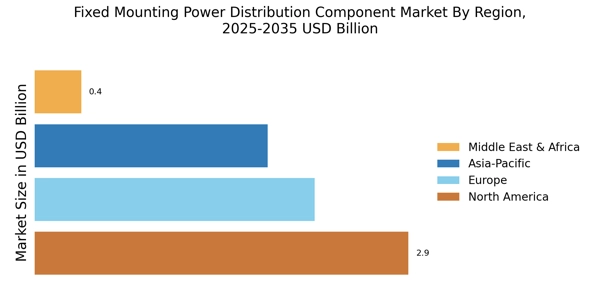The Fixed Mounting Power Distribution Component Market is characterized by a dynamic competitive landscape, driven by increasing demand for reliable power distribution solutions across various sectors, including industrial, commercial, and residential applications. Key players such as Schneider Electric (France), Siemens (Germany), and Eaton (United States) are strategically positioned to leverage their technological expertise and extensive product portfolios. Schneider Electric (France) emphasizes innovation through its EcoStruxure platform, which integrates IoT capabilities to enhance energy management. Siemens (Germany) focuses on digital transformation, investing in smart grid technologies to optimize power distribution efficiency. Meanwhile, Eaton (United States) is pursuing regional expansion, particularly in emerging markets, to capitalize on the growing infrastructure needs. Collectively, these strategies foster a competitive environment that prioritizes technological advancement and customer-centric solutions.
In terms of business tactics, companies are increasingly localizing manufacturing to reduce lead times and enhance supply chain resilience. This approach is particularly relevant in a moderately fragmented market where the collective influence of key players shapes pricing and service standards. The emphasis on supply chain optimization is evident as firms seek to mitigate risks associated with global disruptions, thereby ensuring consistent product availability and reliability.
In August 2025, Schneider Electric (France) announced a partnership with a leading renewable energy firm to develop integrated power distribution solutions tailored for solar energy applications. This strategic move not only aligns with global sustainability goals but also positions Schneider Electric as a frontrunner in the renewable energy sector, potentially enhancing its market share in the growing green technology space. The collaboration underscores the importance of innovation in meeting evolving customer demands for sustainable energy solutions.
In September 2025, Siemens (Germany) launched a new line of smart circuit breakers designed to enhance energy efficiency and provide real-time monitoring capabilities. This product introduction reflects Siemens' commitment to digitalization and smart infrastructure, catering to the increasing demand for intelligent power distribution systems. The integration of advanced monitoring features is likely to attract customers seeking to optimize energy consumption and reduce operational costs, thereby reinforcing Siemens' competitive edge in the market.
In July 2025, Eaton (United States) completed the acquisition of a regional power distribution company, significantly expanding its footprint in the Asia-Pacific market. This acquisition is strategically important as it allows Eaton to tap into the burgeoning demand for power distribution solutions in rapidly developing economies. By enhancing its local presence, Eaton is better positioned to respond to customer needs and adapt to regional market dynamics, which could lead to increased revenue streams and market penetration.
As of October 2025, the competitive trends in the Fixed Mounting Power Distribution Component Market are increasingly defined by digitalization, sustainability, and the integration of artificial intelligence. Strategic alliances are becoming more prevalent, as companies recognize the value of collaboration in driving innovation and enhancing product offerings. Looking ahead, competitive differentiation is likely to evolve from traditional price-based competition to a focus on technological innovation, supply chain reliability, and sustainable practices. This shift suggests that companies that prioritize these aspects will be better equipped to navigate the complexities of the market and meet the demands of a rapidly changing energy landscape.


















Leave a Comment